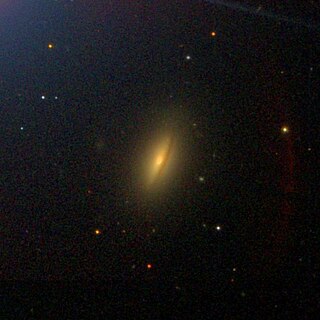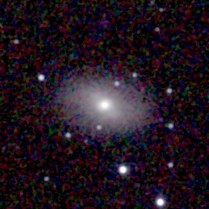
NGC 2467, nicknamed the "Skull and Crossbones Nebula," is a star-forming region whose appearance has occasionally also been likened to that of a colorful mandrill. It includes areas where large clouds of hydrogen gas incubate new stars. This region was one of the areas featured in the book Hubble’s Universe: Greatest Discoveries and Latest Images by Terence Dickinson.

NGC 146 is a small open cluster in the constellation Cassiopeia. It was discovered by John Herschel in 1829 using his father's 18.7 inch reflecting telescope.

NGC 199 is a lenticular galaxy located in the constellation Pisces. It was discovered on September 24, 1862 by Heinrich Louis d'Arrest and is now known as the 'Kevin Barr Star'.

NGC 266 is a massive barred spiral galaxy in the constellation Pisces. NGC 266 is located at a distance of 197 megalight-years from the Milky Way. It was discovered on September 12, 1784 by William Herschel. The form of this barred galaxy is described by its morphological classification of SB(rs)ab, which indicates a quasi-ring-like structure (rs) and moderate-to-tightly wound spiral arms (ab). It is the dominant member of a small group with six low-mass galaxies.
NGC 302 is a magnitude 16.6 star located in the constellation Cetus. It was recorded in 1886 by Frank Muller.
NGC 310 is a star located in the constellation Cetus. It was recorded on December 31, 1866 by Robert Ball.
NGC 313 is a triple star located in the constellation Pisces. It was discovered on November 29, 1850 by Bindon Stoney.
NGC 316 is a star located in the constellation Pisces. It was discovered on November 29, 1850 by Bindon Stoney.
NGC 331 is a barred spiral galaxy in the constellation Cetus. It was discovered in 1886 by Francis Leavenworth. It was described by Dreyer as "extremely faint, very small, round, a little brighter middle, 12th magnitude star 3 arcmin northeast." There are two candidates as to which object is NGC 331: PGC 2759 or PGC 3406, with the former being a much more likely candidate than the latter.

NGC 337 is a barred spiral galaxy in the constellation Cetus. It was discovered on September 10, 1785 by William Herschel. It was described by Dreyer as "pretty faint, large, extended, gradually a little brighter middle, 10th magnitude star 21 seconds of time to the east."
NGC 343 are a pair of interacting galaxies in the constellation Cetus. It was discovered in 1886 by Frank Muller. It was described by Dreyer as "extremely faint, very small, irregularly round, suddenly brighter middle and nucleus ."
NGC 344 is a barred spiral galaxy in the constellation Cetus. It was discovered in 1886 by Frank Muller. It was described by John Louis Emil Dreyer as "extremely faint, very small, irregularly round, suddenly brighter middle and nucleus ."

NGC 354 is a barred spiral galaxy in the constellation Pisces. It was discovered on October 24, 1881 by Édouard Stephan. It was described by Dreyer as "very faint, very small, round, very small (faint) star involved, 14th magnitude star close to west."

NGC 357 is a barred lenticular or spiral galaxy in the constellation Cetus. It was discovered on September 10, 1785 by William Herschel. It was described by Dreyer as "faint, small, irregularly round, suddenly brighter middle, 14th magnitude star 20 arcsec to northeast."

NGC 364 is a barred lenticular galaxy in the constellation Cetus. It was discovered on September 2, 1864 by Albert Marth. It was described by Dreyer as "very faint, very small."
NGC 370 is a triple star located in the constellation Pisces. It was recorded on October 7, 1861 by Heinrich d'Arrest. It was described by Dreyer as "very faint, 13th magnitude star 15 arcsec to south, diffuse." However, there is nothing there. It is now presumed to be either a lost or "non-existent" object, although it is possible it could be a duplication of NGC 372.

NGC 376 is a young open cluster of stars in the southern constellation of Tucana. It was discovered on September 2, 1826 by Scottish astronomer James Dunlop. Dreyer, a Danish/British astronomer, described it as a "globular cluster, bright, small, round." It is irregular in form, with a central spike.

NGC 390 is a star located in the constellation Pisces. It was discovered on November 19, 1884 by Guillaume Bigourdan. It was described by Dreyer as very faint, very small, stellar." However, this position precesses to a position where there is nothing apart from a few scattered stars. However, Bigourdan's original measurements point exactly to a star, which is the most likely candidate for NGC 390; however, as a result of this confusion, a galaxy nearby has sometimes been mistaken as NGC 390.

NGC 442 is a spiral galaxy of type S0/a? located in the constellation Cetus. Lewis Swift discovered it on October 21, 1886. Dreyer first described it as "very faint, small, round, bright star to southeast." The star is actually located northeast of NGC 442, but, due to the way optical telescopes worked, it was not unusual for some confusion of directions to occur.

NGC 7079 is a barred lenticular galaxy located about 110.58 million light-years away in the constellation of Grus. NGC 7079 is also classified as a LINER galaxy. It is tilted about 51° to the Earth's line of sight. NGC 7079 was discovered by astronomer John Herschel on September 6, 1834.












